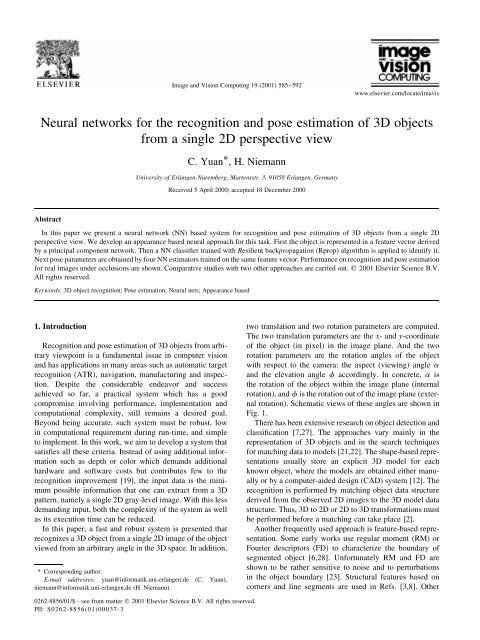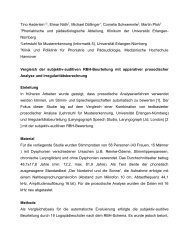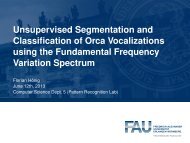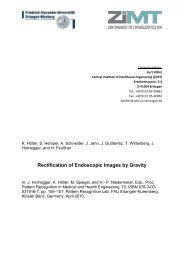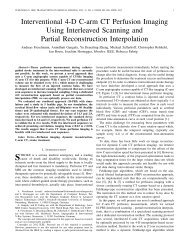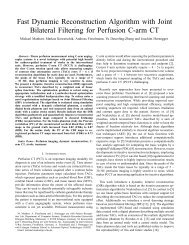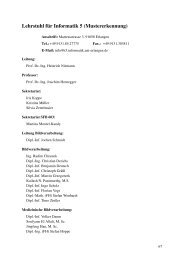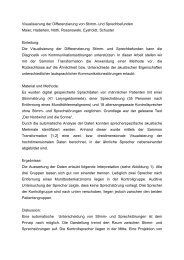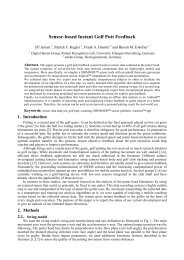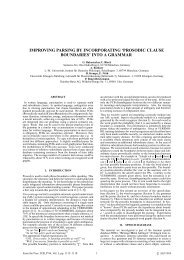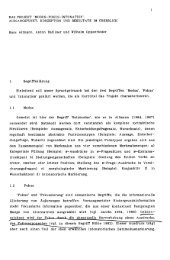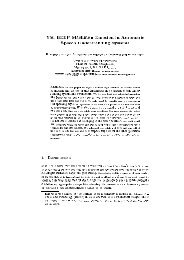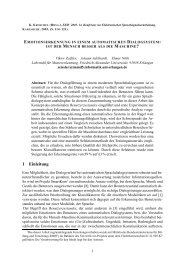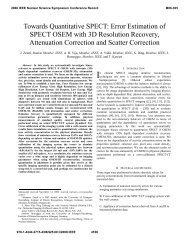Neural networks for the recognition and pose estimation of 3D ...
Neural networks for the recognition and pose estimation of 3D ...
Neural networks for the recognition and pose estimation of 3D ...
Create successful ePaper yourself
Turn your PDF publications into a flip-book with our unique Google optimized e-Paper software.
Image <strong>and</strong> Vision Computing 19 2001) 585±592<br />
www.elsevier.com/locate/imavis<br />
<strong>Neural</strong> <strong>networks</strong> <strong>for</strong> <strong>the</strong> <strong>recognition</strong> <strong>and</strong> <strong>pose</strong> <strong>estimation</strong> <strong>of</strong> <strong>3D</strong> objects<br />
from a single 2D perspective view<br />
C. Yuan*, H. Niemann<br />
University <strong>of</strong> Erlangen-Nuremberg, Martensstr. 3, 91058 Erlangen, Germany<br />
Received 5 April 2000; accepted 18 December 2000<br />
Abstract<br />
In this paper we present a neural network NN) based system <strong>for</strong> <strong>recognition</strong> <strong>and</strong> <strong>pose</strong> <strong>estimation</strong> <strong>of</strong> <strong>3D</strong> objects from a single 2D<br />
perspective view. We develop an appearance based neural approach <strong>for</strong> this task. First <strong>the</strong> object is represented in a feature vector derived<br />
by a principal component network. Then a NN classi®er trained with Resilient backpropagation Rprop) algorithm is applied to identify it.<br />
Next <strong>pose</strong> parameters are obtained by four NN estimators trained on <strong>the</strong> same feature vector. Per<strong>for</strong>mance on <strong>recognition</strong> <strong>and</strong> <strong>pose</strong> <strong>estimation</strong><br />
<strong>for</strong> real images under occlusions are shown. Comparative studies with two o<strong>the</strong>r approaches are carried out. q 2001 Elsevier Science B.V.<br />
All rights reserved.<br />
Keywords: <strong>3D</strong> object <strong>recognition</strong>; Pose <strong>estimation</strong>; <strong>Neural</strong> nets; Appearance based<br />
1. Introduction<br />
Recognition <strong>and</strong> <strong>pose</strong> <strong>estimation</strong> <strong>of</strong> <strong>3D</strong> objects from arbitrary<br />
viewpoint is a fundamental issue in computer vision<br />
<strong>and</strong> has applications in many areas such as automatic target<br />
<strong>recognition</strong> ATR), navigation, manufacturing <strong>and</strong> inspection.<br />
Despite <strong>the</strong> considerable endeavor <strong>and</strong> success<br />
achieved so far, a practical system which has a good<br />
compromise involving per<strong>for</strong>mance, implementation <strong>and</strong><br />
computational complexity, still remains a desired goal.<br />
Beyond being accurate, such system must be robust, low<br />
in computational requirement during run-time, <strong>and</strong> simple<br />
to implement. In this work, we aim to develop a system that<br />
satis®es all <strong>the</strong>se criteria. Instead <strong>of</strong> using additional in<strong>for</strong>mation<br />
such as depth or color which dem<strong>and</strong>s additional<br />
hardware <strong>and</strong> s<strong>of</strong>tware costs but contributes few to <strong>the</strong><br />
<strong>recognition</strong> improvement [19], <strong>the</strong> input data is <strong>the</strong> minimum<br />
possible in<strong>for</strong>mation that one can extract from a <strong>3D</strong><br />
pattern, namely a single 2D gray-level image. With this less<br />
dem<strong>and</strong>ing input, both <strong>the</strong> complexity <strong>of</strong> <strong>the</strong> system as well<br />
as its execution time can be reduced.<br />
In this paper, a fast <strong>and</strong> robust system is presented that<br />
recognizes a <strong>3D</strong> object from a single 2D image <strong>of</strong> <strong>the</strong> object<br />
viewed from an arbitrary angle in <strong>the</strong> <strong>3D</strong> space. In addition,<br />
* Corresponding author.<br />
E-mail addresses: yuan@in<strong>for</strong>matik.uni-erlangen.de C. Yuan),<br />
niemann@in<strong>for</strong>matik.uni-erlangen.de H. Niemann).<br />
two translation <strong>and</strong> two rotation parameters are computed.<br />
The two translation parameters are <strong>the</strong> x- <strong>and</strong> y-coordinate<br />
<strong>of</strong> <strong>the</strong> object in pixel) in <strong>the</strong> image plane. And <strong>the</strong> two<br />
rotation parameters are <strong>the</strong> rotation angles <strong>of</strong> <strong>the</strong> object<br />
with respect to <strong>the</strong> camera: <strong>the</strong> aspect viewing) angle a<br />
<strong>and</strong> <strong>the</strong> elevation angle f accordingly. In concrete, a is<br />
<strong>the</strong> rotation <strong>of</strong> <strong>the</strong> object within <strong>the</strong> image plane internal<br />
rotation), <strong>and</strong> f is <strong>the</strong> rotation out <strong>of</strong> <strong>the</strong> image plane external<br />
rotation). Schematic views <strong>of</strong> <strong>the</strong>se angles are shown in<br />
Fig. 1.<br />
There has been extensive research on object detection <strong>and</strong><br />
classi®cation [7,27]. The approaches vary mainly in <strong>the</strong><br />
representation <strong>of</strong> <strong>3D</strong> objects <strong>and</strong> in <strong>the</strong> search techniques<br />
<strong>for</strong> matching data to models [21,22]. The shape-based representations<br />
usually store an explicit <strong>3D</strong> model <strong>for</strong> each<br />
known object, where <strong>the</strong> models are obtained ei<strong>the</strong>r manually<br />
or by a computer-aided design CAD) system [12]. The<br />
<strong>recognition</strong> is per<strong>for</strong>med by matching object data structure<br />
derived from <strong>the</strong> observed 2D images to <strong>the</strong> <strong>3D</strong> model data<br />
structure. Thus, <strong>3D</strong> to 2D or 2D to <strong>3D</strong> trans<strong>for</strong>mations must<br />
be per<strong>for</strong>med be<strong>for</strong>e a matching can take place [2].<br />
Ano<strong>the</strong>r frequently used approach is feature-based representation.<br />
Some early works use regular moment RM) or<br />
Fourier descriptors FD) to characterize <strong>the</strong> boundary <strong>of</strong><br />
segmented object [6,28]. Un<strong>for</strong>tunately RM <strong>and</strong> FD are<br />
shown to be ra<strong>the</strong>r sensitive to noise <strong>and</strong> to perturbations<br />
in <strong>the</strong> object boundary [23]. Structural features based on<br />
corners <strong>and</strong> line segments are used in Refs. [3,8]. O<strong>the</strong>r<br />
0262-8856/01/$ - see front matter q 2001 Elsevier Science B.V. All rights reserved.<br />
PII: S0262-885601)00037-3
586<br />
C. Yuan, H. Niemann / Image <strong>and</strong> Vision Computing 19 2001) 585±592<br />
Fig. 1. Schematic <strong>of</strong> <strong>the</strong> two rotation parameters.<br />
approaches extract complex features based on geometric/<br />
projective/perspective invariants [13,15,24]. Yet, extraction<br />
<strong>of</strong> such features is not only time consuming but <strong>of</strong>ten<br />
unreliable.<br />
In contrast to <strong>the</strong> above representation paradigm, a<br />
number <strong>of</strong> appearance-based systems have emerged.<br />
Begin with <strong>the</strong> eigenface approach pro<strong>pose</strong>d by Turk <strong>and</strong><br />
Pentl<strong>and</strong> [26] <strong>for</strong> face <strong>recognition</strong>, <strong>and</strong> later extended by<br />
Nayar [18] <strong>and</strong> Murase [17] to general object <strong>recognition</strong>,<br />
appearance-based approach uses a set <strong>of</strong> images obtained<br />
from different views as its implicit description. [25] applies<br />
a probabilistic approach <strong>for</strong> appearance modeling where<br />
receptive ®eld histogram was used to represent objects.<br />
Yet, it is dif®cult to use this histogram-based strategy <strong>for</strong><br />
object <strong>pose</strong> <strong>estimation</strong>. A recent work [20] in this category<br />
applies Gabor wavelet ®lters <strong>for</strong> statistical object localization.<br />
A statistical object model is built whose parameters are<br />
estimated using maximum likelihood <strong>estimation</strong>. A multimatching<br />
strategy is necessary <strong>for</strong> object <strong>pose</strong> <strong>estimation</strong>,<br />
which consists <strong>of</strong> a global <strong>pose</strong> search <strong>and</strong> succeeding local<br />
search. Though it achieves considerable accuracy in parameter<br />
<strong>estimation</strong>, no direct report on <strong>recognition</strong> result can<br />
be found. A comparison <strong>of</strong> this work to our approach on<br />
object <strong>pose</strong> <strong>estimation</strong> can be found in Section 5.<br />
Generally, vision systems must be able to reason about<br />
both identity <strong>and</strong> <strong>pose</strong> <strong>of</strong> objects. In this paper we utilize<br />
several neural nets NNs) <strong>for</strong> appearance-based <strong>recognition</strong><br />
<strong>and</strong> <strong>pose</strong> <strong>estimation</strong>. In this scheme, expensive storage <strong>of</strong> a<br />
multiview database is not needed, since during training <strong>the</strong><br />
NNs are expected to extract all <strong>the</strong> relevant in<strong>for</strong>mation <strong>and</strong><br />
to <strong>for</strong>m a compact representation <strong>of</strong> <strong>the</strong> objects. Also, due to<br />
generalization capability <strong>of</strong> <strong>the</strong> NNs, good results can be<br />
obtained with a relative small number <strong>of</strong> views. The adaptive<br />
feature <strong>of</strong> NNs causes <strong>the</strong> system to be robust <strong>and</strong> to<br />
per<strong>for</strong>m well when distortions are present. Finally since a<br />
trained NN can execute quickly, <strong>the</strong> need <strong>for</strong> slow matching<br />
strategies is eliminated, <strong>and</strong> <strong>the</strong> overall speed <strong>of</strong> <strong>the</strong> system<br />
becomes quite reasonable.<br />
The organization <strong>of</strong> <strong>the</strong> rest <strong>of</strong> this paper is as follows.<br />
Section 2 deals with feature extraction using <strong>the</strong> principal<br />
component network PCN) approach. Section 3 describes<br />
<strong>the</strong> NN classi®er. Pose <strong>estimation</strong> by NN is discussed in<br />
Section 4. Experimental results based on both 2D <strong>and</strong> <strong>3D</strong><br />
objects are presented in Section 5. Finally, Section 6<br />
summarizes <strong>the</strong> whole paper.<br />
2. Feature extraction using principal component<br />
network<br />
A judicious selection <strong>of</strong> features reducing <strong>the</strong> dimensionality<br />
<strong>of</strong> <strong>the</strong> input vector while preserving most <strong>of</strong> <strong>the</strong><br />
intrinsic in<strong>for</strong>mation content is an approach that will<br />
improve <strong>the</strong> generalization <strong>of</strong> a classi®er. Subspace methods<br />
such as Principal Component Analysis PCA) <strong>and</strong> Independent<br />
Component Analysis ICA) are proved to be very effective<br />
ways <strong>for</strong> extracting low-dimensional manifolds from<br />
<strong>the</strong> original data space [4,10]. While ICA seeks statistically<br />
independent <strong>and</strong> non-Gaussian components <strong>and</strong> is suitable<br />
<strong>for</strong> blind source separation, PCA is an eigenvector-based<br />
technique which is commonly used <strong>for</strong> dimensionality<br />
reduction. Through PCA, a n-dimensional pattern vector x<br />
can be mapped to a feature vector c in a m-dimensional<br />
space, where m , n. In o<strong>the</strong>r words, PCA ®nds <strong>the</strong> invertible<br />
trans<strong>for</strong>m T such that truncation <strong>of</strong> x to c …c ˆ T´x† is<br />
optimum in <strong>the</strong> mean square error sense. The linearity <strong>and</strong><br />
invertibility <strong>of</strong> trans<strong>for</strong>m T makes <strong>the</strong> components <strong>of</strong> such<br />
PCA orthogonal, ordered <strong>and</strong> linear.<br />
St<strong>and</strong>ard linear PCA has found wide applications in<br />
pattern <strong>recognition</strong> <strong>and</strong> image processing. Yet <strong>the</strong> linearity<br />
can cause problems in some cases [5]. The alternative nonlinear<br />
PCA builds a non-linear curved) lower-dimensional<br />
surface called principal surface that ªpasses through <strong>the</strong><br />
middle <strong>of</strong> <strong>the</strong> dataº <strong>and</strong> thus yield a relatively accurate<br />
representation <strong>of</strong> <strong>the</strong> data. Sup<strong>pose</strong> functions g <strong>and</strong> h are<br />
two non-linear mapping each from R n to R m <strong>and</strong> from R m to<br />
R n , respectively, <strong>the</strong> target <strong>of</strong> <strong>the</strong> non-linear PCA is <strong>the</strong><br />
minimization <strong>of</strong> <strong>the</strong> non-linear reconstruction mean squared<br />
error<br />
J ˆ Eix 2 h…g…x††i 2<br />
by an optimal choice <strong>of</strong> g <strong>and</strong> h.<br />
…1†
C. Yuan, H. Niemann / Image <strong>and</strong> Vision Computing 19 2001) 585±592 587<br />
One <strong>of</strong> <strong>the</strong> simplest methods <strong>for</strong> computing non-linear<br />
principal manifolds is <strong>the</strong> PCNs which has a non-linear<br />
hidden layer incorporating <strong>the</strong> sigmoid activation function<br />
[29]. As shown in Fig. 2a), <strong>the</strong> output <strong>of</strong> <strong>the</strong> network is set<br />
to be equal to <strong>the</strong> input pattern vector x, because it is to be<br />
trained to reproduce <strong>the</strong> input x. And <strong>the</strong> hidden unit activations<br />
correspond to a feature vector c in R m . The mapping<br />
from <strong>the</strong> input layer to hidden layer <strong>and</strong> from <strong>the</strong> hidden<br />
layer to <strong>the</strong> output layer can be regarded accordingly as<br />
<strong>the</strong> non-linear function g <strong>and</strong> h. The main advantage <strong>of</strong><br />
PCN is that it can be done automatically <strong>and</strong> no prior<br />
knowledge regarding <strong>the</strong> joint distribution <strong>of</strong> <strong>the</strong> components<br />
is necessary. It has been shown in Refs. [1,9] that,<br />
a PCN with linear functions can be made to converge to<br />
<strong>the</strong> principal components. Intuitively, one expects a<br />
greater discriminative power to result from <strong>the</strong> non-linear<br />
neurons.<br />
We are interested not in <strong>the</strong> exact principal components,<br />
but in components <strong>of</strong> variables, or features, which are nonlinearly<br />
related to <strong>the</strong> input variables. Thus in our implementation,<br />
we ®rst train a 4-1-4 PCN <strong>and</strong> <strong>the</strong>n apply <strong>the</strong><br />
result function g hierarchically to <strong>the</strong> input image f 0<br />
256 £ 256 pixels). During <strong>the</strong> training process <strong>the</strong> network<br />
receives <strong>the</strong> 2 £ 2 subimages which are cut sequentially out<br />
<strong>of</strong> f 0 without overlap. The result function g is similar to that<br />
<strong>of</strong> a lowpass ®lter:<br />
!<br />
X 4<br />
g…x† ˆAct …w k x k 1 u†<br />
…2†<br />
kˆ1<br />
where w k , u are <strong>the</strong> weight vector <strong>and</strong> thresholds <strong>of</strong> <strong>the</strong><br />
hidden neuron <strong>and</strong> Acts) <strong>the</strong> sigmoid activation functions<br />
1=…1 1 exp…2s††: Apply <strong>the</strong> function g one time, we get an<br />
image f 1 which is one-fourth <strong>of</strong> <strong>the</strong> original image f 0 see<br />
Fig. 2b)). By repeating such operation<br />
f n …i; j† ˆg p f n21 …i; j†<br />
…3†<br />
four times, we get a feature vector c ˆ f 4 ; which is <strong>of</strong> 256<br />
16 £ 16) dimensions <strong>and</strong> will be used in <strong>the</strong> subsequent<br />
<strong>recognition</strong> <strong>and</strong> localization process.<br />
3. <strong>Neural</strong> classi®er<br />
To recognize an object, we need to classify it as belonging<br />
to one class V k out <strong>of</strong> k object classes V l , l ˆ 1; ¼; k<br />
based on <strong>the</strong> feature vector c. A three layer feed-<strong>for</strong>ward<br />
network whose input neuron numbers equal to <strong>the</strong> dimension<br />
<strong>of</strong> c <strong>and</strong> whose output neuron numbers equal to k can be<br />
applied to <strong>for</strong>m a model <strong>for</strong> classi®cation. The output <strong>of</strong> <strong>the</strong><br />
net o l , l ˆ 1; ¼; k can be interpreted as measuring <strong>the</strong><br />
posterior possibility function pV l uc) <strong>for</strong> each class.<br />
According to Bayes rule, vector c should be classi®ed as<br />
coming from V k with k ˆ argmax{o l }; l ˆ 1; ¼; k: In<br />
order to reject objects that do not belong to any <strong>of</strong><br />
<strong>the</strong> classes, additional criteria have been incorporated into<br />
<strong>the</strong> system. Let k 2 ˆ argmax{o l }; l ˆ 1; ¼; k; l ± k, <strong>the</strong><br />
image with feature vector c can be classi®ed as containing<br />
an object <strong>of</strong> class V k only if:<br />
o k $ Q 0<br />
…4†<br />
<strong>and</strong><br />
o k<br />
o k2<br />
$ Q 1 …5†<br />
Q 0 <strong>and</strong> Q 1 are ®xed be<strong>for</strong>e <strong>the</strong> experiment. Since <strong>the</strong> neuron<br />
output can vary between 0.0 <strong>and</strong> 1.0, we set Q 0 ˆ 0:6 <strong>for</strong> all<br />
<strong>the</strong> NNs we use. As to Q 1 , it is set based on experience to<br />
Q 1 ˆ 1:3:<br />
The number <strong>of</strong> hidden nodes <strong>of</strong> <strong>the</strong> neural classi®er is set<br />
by trail <strong>and</strong> error, varying from 20 to 80. By alternating <strong>the</strong><br />
number <strong>of</strong> hidden nodes, a best net can be found, which can<br />
make <strong>the</strong> comparison <strong>of</strong> different approaches more reasonable.<br />
Training is done with <strong>the</strong> Rprop algorithm, which we<br />
describe brie¯y in <strong>the</strong> following. The basic principle <strong>of</strong><br />
Rprop is to eliminate <strong>the</strong> harmful in¯uence <strong>of</strong> <strong>the</strong> size <strong>of</strong><br />
<strong>the</strong> partial derivative on <strong>the</strong> weight step. As a consequence,<br />
only <strong>the</strong> sign <strong>of</strong> <strong>the</strong> derivate is considered to indicate <strong>the</strong><br />
direction <strong>of</strong> <strong>the</strong> weight update. Concretely <strong>the</strong> weight<br />
change Dw …t† is determined as follows:<br />
Dw …t†<br />
ij<br />
ij<br />
8<br />
2D …t†<br />
ij if<br />
><<br />
ˆ<br />
1D …t†<br />
ij if<br />
>:<br />
0 else<br />
2E<br />
2w ij<br />
…t†<br />
. 0<br />
2E<br />
2w ij<br />
…t†<br />
, 0<br />
Then <strong>the</strong> new update-value D …t11†<br />
ij is determined, basing on a<br />
sign-dependent adaptation process<br />
D …t11†<br />
ij<br />
8<br />
><<br />
ˆ<br />
>:<br />
h 1 p D …t†<br />
ij<br />
h 2 p D …t†<br />
ij<br />
D …t†<br />
ij<br />
if<br />
if<br />
else<br />
2E<br />
2w ij<br />
…t21†<br />
p 2E<br />
2w ij<br />
…t†<br />
. 0<br />
2E<br />
2w ij<br />
…t21†<br />
p 2E<br />
2w ij<br />
…t†<br />
, 0<br />
where 0 , h 2 , 1 , h 1 .<br />
In our experiment we set h 1 ˆ 1:2 <strong>and</strong> h 2 ˆ 0:5:<br />
Because Rprop modi®es <strong>the</strong> size <strong>of</strong> <strong>the</strong> weight-step directly<br />
by introducing <strong>the</strong> concept <strong>of</strong> resilient update-value D ij ,it<br />
converges very fast. Ano<strong>the</strong>r advantage is that no special<br />
choice <strong>of</strong> parameters is needed at all to obtain optimal or at<br />
least nearly optimal convergence time.<br />
4. <strong>Neural</strong> <strong>pose</strong> estimator<br />
After <strong>the</strong> object is recognized, <strong>the</strong> module that provides<br />
<strong>estimation</strong> <strong>of</strong> its <strong>pose</strong> parameters, namely <strong>the</strong> translation <strong>and</strong><br />
rotation parameters is activated. The module consists <strong>of</strong> two<br />
stages with <strong>the</strong> ®rst one estimating <strong>the</strong> x- <strong>and</strong> y-coordinates<br />
<strong>of</strong> <strong>the</strong> recognized object in <strong>the</strong> image plane <strong>and</strong> <strong>the</strong> second<br />
one providing <strong>the</strong> <strong>estimation</strong> <strong>of</strong> <strong>the</strong> internal <strong>and</strong> external<br />
…6†<br />
…7†
588<br />
C. Yuan, H. Niemann / Image <strong>and</strong> Vision Computing 19 2001) 585±592<br />
Fig. 2. a) Topology <strong>of</strong> PCN. b) Hierarchic feature generation.<br />
rotation parameters. At each stage, <strong>the</strong> task is partitioned<br />
into simpler sub-problems, <strong>and</strong> multiple NNs are utilized to<br />
solve it. Each <strong>of</strong> <strong>the</strong>se NNs receives <strong>the</strong> same feature vector<br />
as <strong>the</strong> NN classi®er.<br />
For computing <strong>of</strong> <strong>the</strong> translation parameters in x <strong>and</strong> y<br />
direction, two three-layer feed-<strong>for</strong>ward NNs are implemented<br />
<strong>for</strong> each <strong>of</strong> <strong>the</strong> object class. Different from <strong>the</strong> NN <strong>for</strong><br />
classi®cation which is a full connected one <strong>the</strong>re is only<br />
horizontal or vertical connection between <strong>the</strong> input layer<br />
<strong>and</strong> <strong>the</strong> hidden layer as illustrated in Fig. 3. Also <strong>the</strong>y are<br />
NN estimators ra<strong>the</strong>r than classi®ers. As shown in Fig. 3,<br />
each estimator has 16 neurons in <strong>the</strong> hidden layer <strong>and</strong> one<br />
output neuron. The output <strong>of</strong> each estimator is a real value<br />
between 0 <strong>and</strong> 1. By multiplying <strong>the</strong> output with <strong>the</strong> width<br />
or height <strong>of</strong> <strong>the</strong> image which is in our case both 256 pixel,<br />
we obtain <strong>the</strong> object position in x or y direction, respectively.<br />
For each <strong>of</strong> <strong>the</strong> object classes, two NN estimators with<br />
identical architecture are con®gured to estimate <strong>the</strong> two<br />
rotation angles a <strong>and</strong> f. In contrast to <strong>the</strong> translation parameter<br />
estimators which approximate <strong>the</strong> geometric center <strong>of</strong><br />
<strong>the</strong> objects, we try to distinguish <strong>the</strong> different views as<br />
different rotation categories <strong>of</strong> an object. For this reason, a<br />
topology different from that <strong>of</strong> <strong>the</strong> translation parameter<br />
estimators is chosen. As Fig. 4 illustrates, each estimator<br />
receives <strong>the</strong> same feature vector <strong>and</strong> has only one output<br />
neuron. By initialization, <strong>the</strong> number <strong>of</strong> neurons in <strong>the</strong><br />
hidden layer is equal to <strong>the</strong> discrete number <strong>of</strong> possible<br />
different category <strong>of</strong> viewing angles. For example, both a<br />
<strong>and</strong> f span from 2458 to 458 in our <strong>3D</strong> experiment. And <strong>the</strong><br />
interval <strong>of</strong> viewing angles is D ˆ 38 both in <strong>the</strong> internal <strong>and</strong><br />
external rotation). In this situation, each rotation estimator<br />
should have N ˆ 30 hidden neurons arranged in ascending<br />
order at <strong>the</strong> initialization stage Fig. 4). Moreover views<br />
with rotation angles belonging to [nD, n 1 1)D),<br />
0 # n , N, are in <strong>the</strong> same rotation category. Though<br />
<strong>the</strong>re is only N different rotation categories, within<br />
each rotation category, <strong>the</strong> views can have a difference<br />
within D.<br />
Because <strong>of</strong> <strong>the</strong>ir particular topology, training <strong>of</strong> <strong>the</strong> rotation<br />
parameter estimators is done with <strong>the</strong> dynamic learning<br />
vector quantization DLVQ) algorithm [30]. With DLVQ a<br />
natural grouping in a set <strong>of</strong> data can be found very quickly.<br />
Since vectors belonging to <strong>the</strong> same class in our case with<br />
<strong>the</strong> same rotation category) should have smaller difference<br />
than those belonging to different classes different rotation<br />
categories), we estimate <strong>the</strong> rotation angles by trying to ®nd<br />
a natural grouping in <strong>the</strong> set <strong>of</strong> image data. The ma<strong>the</strong>matic<br />
<strong>for</strong>mulation <strong>of</strong> this training algorithm is as follows: Sup<strong>pose</strong><br />
that <strong>the</strong> vector c i belonging to <strong>the</strong> same class in our case<br />
within <strong>the</strong> same category <strong>of</strong> perspective views) are distributed<br />
normally with a mean vector m i . A feature vector c is<br />
assigned to <strong>the</strong> class V i with <strong>the</strong> smallest Euclidean distance<br />
im i 2 ci 2 : During <strong>the</strong> learning phase, <strong>the</strong> algorithm<br />
computes a new mean vector m i <strong>for</strong> each class once every<br />
cycle <strong>and</strong> generates <strong>the</strong> hidden layer dynamically. Training<br />
is ®nished when correct m i is found stable <strong>for</strong> every class.<br />
After training <strong>the</strong> network outputs a natural number n<br />
0 # n , N). The rotation angle is computed as to be<br />
equal to n p D.<br />
Fig. 3. Translation parameter estimators.<br />
Fig. 4. Topology <strong>of</strong> <strong>the</strong> rotation parameter estimators.
C. Yuan, H. Niemann / Image <strong>and</strong> Vision Computing 19 2001) 585±592 589<br />
Fig. 5. Objects used in <strong>the</strong> ®rst experiment.<br />
5. Experimental study<br />
Though <strong>the</strong>re exist some image databases such as <strong>the</strong><br />
famous Colombia image database, most such databases are<br />
designed <strong>for</strong> <strong>recognition</strong>, but not <strong>for</strong> <strong>pose</strong> <strong>estimation</strong>. And<br />
<strong>the</strong> unavailability <strong>of</strong> <strong>the</strong> original objects make it unfavorable<br />
in such situation where real-time application must be developed.<br />
Our goal is to develop an object <strong>recognition</strong> system to be<br />
used later by a service robot which can act in an <strong>of</strong>®ce or a<br />
home environment. For <strong>the</strong> robot to be able to locate <strong>and</strong> grasp<br />
objects, we develop in <strong>the</strong> ®rst step a neural system <strong>for</strong> object<br />
<strong>recognition</strong> <strong>and</strong> <strong>pose</strong> <strong>estimation</strong>. The system is built on a SGI<br />
O2 R10000) workstation, which is connected to a CCDcamera<br />
focal length ˆ 16 mm) mounted on a robot Scorbot<br />
ER-VII). By now, two experiments have been carried out on<br />
<strong>the</strong> system. The ®rst experiment is based on ®ve 2D objects<br />
shown in Fig. 5. By <strong>the</strong>se objects <strong>the</strong>re exists only <strong>the</strong> internal<br />
rotation a. In <strong>the</strong> second experiment we use three <strong>3D</strong> objects<br />
a), b) <strong>and</strong> c) shown in Fig. 6. All <strong>the</strong> images have a dimension<br />
<strong>of</strong> 256 £ 256 pixels with <strong>the</strong> objects appearing in uni<strong>for</strong>m<br />
scale. It takes about 0.5 s <strong>for</strong> feature extraction, <strong>recognition</strong><br />
<strong>and</strong> <strong>pose</strong> <strong>estimation</strong> altoge<strong>the</strong>r. The achieved precision <strong>of</strong> <strong>the</strong><br />
computed object center using neural estimators is in average<br />
1.2 pixel. And <strong>the</strong> average errors <strong>of</strong> <strong>the</strong> rotation parameter are<br />
1.88 <strong>for</strong> <strong>the</strong> internal rotation a <strong>and</strong> 2.68 <strong>for</strong> <strong>the</strong> external rotation<br />
f.<br />
In <strong>the</strong> 2D experiment, 400 images are taken with 10<br />
different positions <strong>and</strong> 40 different rotation categories <strong>for</strong><br />
each object class. The image data is divided into training<br />
<strong>and</strong> test samples r<strong>and</strong>omly, so that some views <strong>of</strong> <strong>the</strong> test<br />
images have never appeared in <strong>the</strong> training process at all.<br />
Training set consists <strong>of</strong> 160 images/class, Test set consists<br />
<strong>of</strong> 240 image/class. The achieved <strong>recognition</strong> results on <strong>the</strong><br />
test set using PCN as well as different wavelet trans<strong>for</strong>m are<br />
shown in Table 1. As we know, a 2D discrete wavelet trans<strong>for</strong>m<br />
is computed by applying a separable ®lterbank to <strong>the</strong><br />
image repeatedly [16]. Through lowpass ®lter H followed<br />
by subsampling along image rows <strong>and</strong> columns, a low resolution<br />
image can be retrieved, which can be denoted ma<strong>the</strong>matically<br />
as follows:<br />
f n …x; y† ˆ‰H x p ‰H y p f n21 Š u2;1 Š u1;2 …x; y†<br />
By applying <strong>the</strong> lowpass ®lter H four times, we can get <strong>the</strong><br />
wavelet feature vector f 4 , which has <strong>the</strong> same dimension as<br />
<strong>the</strong> PCN <strong>networks</strong>. As <strong>for</strong> <strong>the</strong> description <strong>of</strong> <strong>the</strong> coef®cients<br />
<strong>of</strong> <strong>the</strong> different kinds <strong>of</strong> wavelet trans<strong>for</strong>ms, please refer to<br />
Ref. [11]. Though <strong>the</strong> similarity <strong>of</strong> <strong>the</strong> three kinds <strong>of</strong> lid<br />
makes <strong>the</strong> <strong>recognition</strong> task a very dif®cult one, PCN based<br />
feature extraction achieves an average <strong>recognition</strong> rate <strong>of</strong><br />
99.6%. The best wavelet-based features resulted from<br />
Daubechies 4-tap wavelet, which is more than 1% lower<br />
than that <strong>of</strong> <strong>the</strong> PCN feature. Ano<strong>the</strong>r superiority <strong>of</strong> <strong>the</strong><br />
PCN feature detector is its fast convergence during training,<br />
which can be obviously seen from Fig. 7.<br />
In <strong>the</strong> <strong>3D</strong> experiment, Each object is available in four image<br />
sequences with 6144 image each. Each sequence is taken<br />
under a different illumination. Under each illumination,<br />
objects are taken having translational variation within <strong>the</strong><br />
whole image plane <strong>and</strong> rotational variation both a <strong>and</strong> f)<br />
<strong>of</strong> 908. This means that <strong>for</strong> each object, <strong>the</strong>re are 24,576 images<br />
taken in different positions, at different perspective viewpoints,<br />
<strong>and</strong> with different lightning conditions. Here we divide<br />
<strong>the</strong> four sequences into two disjoint parts: training data <strong>and</strong> test<br />
data. The test data is fur<strong>the</strong>r subdivided into a validation set<br />
<strong>and</strong> a test set. The training data is used <strong>for</strong> training <strong>the</strong> network.<br />
The validation set is used to estimate network per<strong>for</strong>mance<br />
during training as we use <strong>the</strong> early stopping criteria to avoid<br />
over®tting. Yet, <strong>the</strong> validation set is never used <strong>for</strong> weight<br />
adjustment. There<strong>for</strong>e it is used with <strong>the</strong> test set toge<strong>the</strong>r to<br />
evaluate <strong>the</strong> network per<strong>for</strong>mance after training is ®nished.<br />
Training set consists <strong>of</strong> 2048 images/class, which are<br />
…8†<br />
Fig. 6. Objects used in <strong>the</strong> second experiment.
590<br />
Table 1<br />
Recognition results-2D experiment<br />
Recognition rate %)<br />
C. Yuan, H. Niemann / Image <strong>and</strong> Vision Computing 19 2001) 585±592<br />
Table 2<br />
Results <strong>of</strong> <strong>3D</strong> object <strong>recognition</strong><br />
Approach Object Recognition rate %)<br />
Lid0 Lid1 Lid2 Case Fan Aver.<br />
PCN 100 98.3 100 100 99.6 99.6<br />
Haar 100 91.3 99.6 100 100 98.2<br />
Daub4 99.6 93.75 98.3 100 99.6 98.25<br />
Daub6 100 91.7 98.3 100 99.2 98.0<br />
Daub7 100 91.3 99.6 99.6 98.75 97.8<br />
Daub9 99.6 82.5 100 100 97.5 95.9<br />
QMF8 100 87.5 100 100 99.2 97.3<br />
QMF12 100 92.1 98.75 100 99.6 98.1<br />
Villa6 100 83.3 99.6 100 100 96.6<br />
Zhu4 93.75 79.2 98.3 100 97.9 93.75<br />
QZ10 100 75.9 100 99.6 99.6 95.0<br />
r<strong>and</strong>omly selected only from <strong>the</strong> ®rst <strong>and</strong> second sequence.<br />
Ano<strong>the</strong>r 2048 images/class r<strong>and</strong>omly selected from <strong>the</strong> third<br />
<strong>and</strong> fourth sequence <strong>for</strong>m <strong>the</strong> validation set. And <strong>the</strong> rest are<br />
used as test set. As such, <strong>the</strong> ratio <strong>of</strong> <strong>the</strong> amount <strong>of</strong> training<br />
data, validation set<strong>and</strong> test set is 1:1:10.<br />
To evaluate <strong>the</strong> system per<strong>for</strong>mance on <strong>the</strong> <strong>3D</strong> objects,<br />
®rst we have compared <strong>the</strong> PCN with Kohonen's sel<strong>for</strong>ganization<br />
feature map SOM). As <strong>the</strong>re is not enough<br />
room here, we refer to Ref. [14] <strong>for</strong> a detailed description<br />
<strong>of</strong> <strong>the</strong> SOM-based feature extraction method. The total<br />
processing time <strong>for</strong> feature extraction, <strong>recognition</strong> <strong>and</strong><br />
<strong>pose</strong> <strong>estimation</strong> using SOM is 1.6 s on <strong>the</strong> same SGI workstation.<br />
Since <strong>the</strong> dimension <strong>of</strong> <strong>the</strong> feature vector resulting<br />
from this method is also 256, which is <strong>the</strong> same with our<br />
PCN features, we can compare <strong>the</strong> in¯uence <strong>of</strong> SOMfeature<br />
<strong>and</strong> our PCN-feature on <strong>the</strong> NN classi®er as well<br />
as NN estimators with same network architecture. In both<br />
Without occlusion when hidden<br />
neurons ˆ<br />
30 42 56 64 56<br />
PCN a) 97.6 98.4 98.4 98.3 67.1<br />
b) 92.3 93.2 93.8 93.4 87.5<br />
c) 97.2 97.8 99.2 98.2 88.4<br />
SOM a) 96.5 96.3 97.1 96.5 57.4<br />
b) 90.9 91.8 92.0 92.0 78.1<br />
c) 93.1 93.8 93.9 93.2 76.9<br />
With<br />
occlusion<br />
with<br />
hidden<br />
neurons ˆ<br />
cases, we vary <strong>the</strong> number <strong>of</strong> neurons in <strong>the</strong> hidden layer<br />
from 20 to 80 so as to ®nd <strong>the</strong> best classi®er. The best results<br />
are achieved with <strong>the</strong> number <strong>of</strong> hidden neurons between 30<br />
<strong>and</strong> 64. Using <strong>the</strong> best NN con®gurations, we fur<strong>the</strong>r test <strong>the</strong><br />
robustness <strong>of</strong> both approach PCN <strong>and</strong> SOM) <strong>for</strong> new views<br />
<strong>and</strong> in case <strong>of</strong> noise <strong>and</strong> occlusion. For this reason,<br />
Gaussian noise with zero mean <strong>and</strong> a st<strong>and</strong>ard deviation<br />
up to 75 is added to <strong>the</strong> images after objects are<br />
occluded up to 60% as shown in Fig. 6d). Since occlusion<br />
is done by translating or rotating <strong>the</strong> objects out <strong>of</strong><br />
<strong>the</strong>ir image plane, <strong>the</strong> resulted images have not only<br />
noise <strong>and</strong> occlusion, but also views different from <strong>the</strong><br />
original data. Through such operations, a new data set<br />
with 4096 images/class is generated.<br />
Fur<strong>the</strong>rmore we compared our approach with <strong>the</strong> statistical<br />
Fig. 7. Convergence <strong>of</strong> <strong>the</strong> neural classi®er.
C. Yuan, H. Niemann / Image <strong>and</strong> Vision Computing 19 2001) 585±592 591<br />
Table 3<br />
Results <strong>of</strong> <strong>3D</strong> object <strong>pose</strong> <strong>estimation</strong><br />
Object Approach Fail %) Error<br />
Transl. Pix) Int.rot. 8) Ext.rot. 8)<br />
Mean Max Mean Max Mean Max<br />
a) PCN 0 1.1 2.8 1.1 3.4 2.3 6.8<br />
SOM 17 1.1 2.4 3.7 6.8 4.3 6.8<br />
STA. 0 1.1 2.5 1.3 3.4 1.3 6.8<br />
b) PCN 4 0.8 1.5 1.7 6.8 3.2 6.8<br />
SOM 34 0.9 2.9 4.5 6.8 5.4 6.8<br />
STA 15 1.8 3.5 1.3 5.9 3.7 8.9<br />
c) PCN 2 1.4 2.6 2.7 6.8 2.2 6.8<br />
SOM 23 1.7 4.4 4.3 6.8 5.7 6.8<br />
STA. 18 2.5 5.3 1.4 3.4 3.5 8.6<br />
one described in Ref. [20] <strong>for</strong> <strong>pose</strong> <strong>estimation</strong>. On <strong>the</strong><br />
same machine it takes about 6 s <strong>for</strong> feature extraction <strong>and</strong><br />
localization <strong>of</strong> one <strong>of</strong> <strong>the</strong> objects by this approach, which is<br />
much time consuming than our neural approach.<br />
We summarize <strong>the</strong> per<strong>for</strong>mance <strong>of</strong> our system as well as<br />
<strong>the</strong> o<strong>the</strong>r two approaches named as SOM <strong>and</strong> STA, respectively)<br />
in tables as follows: Table 2 lists <strong>the</strong> <strong>recognition</strong> rate<br />
<strong>of</strong> <strong>the</strong> three objects on <strong>the</strong> test data using <strong>the</strong> two different<br />
feature extraction methods. The precision <strong>of</strong> <strong>pose</strong> <strong>estimation</strong><br />
using all three different approaches is shown in Table 3. An<br />
<strong>estimation</strong> result is regarded as failure if <strong>the</strong> resulted translation<br />
error is more than 10 pixels or <strong>the</strong> rotation error is<br />
more than 98.<br />
As shown in Table 2, both PCN <strong>and</strong> SOM approach<br />
achieve <strong>the</strong>ir best <strong>recognition</strong> results when <strong>the</strong>re are 56<br />
neurons in <strong>the</strong> hidden layer. One can see no big difference<br />
on <strong>the</strong> <strong>recognition</strong> rate when <strong>the</strong> number <strong>of</strong> hidden neurons<br />
are between 30 <strong>and</strong> 56. This proves in somewhat <strong>the</strong> effectiveness<br />
<strong>of</strong> <strong>the</strong> Rprop training algorithm. At <strong>the</strong> same time,<br />
slight degradation <strong>of</strong> <strong>the</strong> <strong>recognition</strong> rate can also be seen<br />
when <strong>the</strong>re are more than 56 neurons in <strong>the</strong> hidden layer.<br />
This complies with <strong>the</strong> generally believed weak generation<br />
resulting from an over®tting provided by too many hidden<br />
neurons in a net. In average <strong>the</strong> <strong>recognition</strong> rate is 97.1% by<br />
PCN <strong>and</strong> 94.3% by SOM. Under occlusion <strong>and</strong> noise, PCN<br />
achieved an average <strong>recognition</strong> rate <strong>of</strong> 77%, while SOM<br />
got near to 70%. As to <strong>pose</strong> <strong>estimation</strong> accuracy, <strong>the</strong><br />
average estimated precision in translation is 1.1 pixel by<br />
PCN, 1.2 pixel by SOM <strong>and</strong> 1.8 pixel by STA. Based on<br />
PCN, SOM, <strong>and</strong> STA approach accordingly, <strong>the</strong>re is in<br />
average 1.88, 3.28 <strong>and</strong> 1.38 <strong>estimation</strong> error in <strong>the</strong> internal<br />
rotation parameters <strong>and</strong> 2.68, 5.28 <strong>and</strong> 2.88 in <strong>the</strong> external<br />
rotation parameters. While SOM achieves comparable<br />
<strong>recognition</strong> rate with PCN approach, it is shown through<br />
this study that it has a poorer localization ability. There<strong>for</strong>e,<br />
we argue that feature extraction through PCN appears to be<br />
a promising one. Also in run-time effectiveness, PCN<br />
outper<strong>for</strong>ms <strong>the</strong> SOM as well as STA. Though we cannot<br />
see big per<strong>for</strong>mance difference on <strong>pose</strong> <strong>estimation</strong> exactness<br />
between <strong>the</strong> statistical <strong>and</strong> our neural approach from Table<br />
3, <strong>the</strong> overall fail <strong>estimation</strong> <strong>of</strong> our approach is much lower.<br />
Also quite different from <strong>the</strong> STA method, whose localization<br />
per<strong>for</strong>mance changes when different object is<br />
presented, PCN shows a much lower per<strong>for</strong>mance variance<br />
on all three objects. Hence <strong>the</strong> neural approach proves itself<br />
to be relatively more robust <strong>and</strong> stable than <strong>the</strong> statistical<br />
one.<br />
6. Conclusion<br />
We developed an automatic system <strong>for</strong> <strong>the</strong> <strong>recognition</strong><br />
<strong>and</strong> <strong>pose</strong> <strong>estimation</strong> <strong>of</strong> <strong>3D</strong> objects viewed from arbitrary<br />
location <strong>and</strong> perspective angles, where NN <strong>the</strong>ory is widely<br />
applied to model <strong>the</strong> object appearance. The effectiveness<br />
<strong>and</strong> accuracy <strong>of</strong> <strong>the</strong> pro<strong>pose</strong>d system is demonstrated in two<br />
experiments involving a data set <strong>of</strong> eight objects. Comparative<br />
studies with two o<strong>the</strong>r approaches, a neural <strong>and</strong> a statistical<br />
one, are carried out. It is shown that our system is more<br />
accurate, robust <strong>and</strong> faster than <strong>the</strong> o<strong>the</strong>r two approaches. It<br />
is concluded that with <strong>the</strong> pro<strong>pose</strong>d appearance based neural<br />
approach, <strong>recognition</strong> <strong>and</strong> <strong>pose</strong> <strong>estimation</strong> <strong>of</strong> <strong>3D</strong> objects can<br />
be per<strong>for</strong>med with low computational requirement <strong>and</strong> high<br />
accuracy. Currently we are applying this neural approach to<br />
a set <strong>of</strong> fourteen <strong>3D</strong> objects cup, plate, box, bottle, <strong>for</strong>k,<br />
spoon, knife, two kinds <strong>of</strong> cola dose, two kinds <strong>of</strong> stapler<br />
<strong>and</strong> three kinds <strong>of</strong> hole puncher) <strong>and</strong> have achieved a similar<br />
<strong>recognition</strong> rate. In <strong>the</strong> future, we will enhance <strong>the</strong> pro<strong>pose</strong>d<br />
method to cope with scenes with more than one object<br />
appearing be<strong>for</strong>e heterogeneous background.<br />
References<br />
[1] H. Boulard, Y. Kamp, Auto-association by multilayer perceptrons <strong>and</strong><br />
singular value decomposition, Biological Cybernetics 59 1988)<br />
291±294.<br />
[2] J.L. Chen, G.C. Stockman, Matching curved 3d object models to 2d<br />
images, CAD-Based Vision Workshop, 1994, pp. 210±218.
592<br />
C. Yuan, H. Niemann / Image <strong>and</strong> Vision Computing 19 2001) 585±592<br />
[3] S.W. Chen, A.K. Jain, Strategies <strong>of</strong> multi-view <strong>and</strong> multi-matching<br />
<strong>for</strong> 3d object <strong>recognition</strong>, CVGIP 57 1) 1993) 121±130.<br />
[4] P. Comon, Independent component analysis: a new concept?, Signal<br />
Processing 36 1994) 287±314.<br />
[5] K.I. Diamantaras, S.Y. Kung, Principal Component <strong>Neural</strong> Networks:<br />
Theory <strong>and</strong> Applications, Wiley, New York, 1996.<br />
[6] S.A. Dudani, K.J. Breeding, R.B. McGhee, Aircraft identi®cation by<br />
moment invariants, IEEE Transactions on Computer 26 1) 1977)<br />
39±46.<br />
[7] S. Edelman, On learning to recognize 3-d objects from examples,<br />
IEEE Transactions on PAMI 15 8) 1993) 833±837.<br />
[8] J. Hornegger, H. Niemann, Statistical learning, localization, <strong>and</strong> identi®cation<br />
<strong>of</strong> objects, ICCV95, 1995, pp. 914±919.<br />
[9] A. Hornik, M. Strinchcombe, H. White, Multilayer feed<strong>for</strong>ward<br />
<strong>networks</strong> are universal approximators, <strong>Neural</strong> Networks 2 1989)<br />
359±366.<br />
[10] I.T. Jolliffe, Principal Component Analysis, Springer, New York,<br />
1986.<br />
[11] P. Kral, Wavelet Trans<strong>for</strong>ms, Chair <strong>for</strong> Pattern Recognition, University<br />
<strong>of</strong> Erlangen-Nuernberg, 1995.<br />
[12] B. Krebs, F.M. Wahl, Automatic generation <strong>of</strong> bayesian net <strong>for</strong> 3d<br />
object <strong>recognition</strong>, ICPR98, 1998, pp. 126±128.<br />
[13] Y. Kuno, O. Takae, T Takahashi, Y. Shirai, Object <strong>recognition</strong> using<br />
multiple view invariance based on complex features, WACV96, 1996,<br />
pp. 129±134.<br />
[14] H.M. Lakany, E.-G. Schukat-Talamazzini, H. Niemann, M.<br />
Ghoneimy, Object <strong>recognition</strong> from 2d images using kohonen's<br />
self-organized feature maps, Pattern Recognition <strong>and</strong> Image Analysis<br />
7 3) 1997) 301±308.<br />
[15] D.G. Lowe, Object <strong>recognition</strong> from local scale-invariant features,<br />
ICCV99, 1999, pp. 1150±1157.<br />
[16] S. Mallat, A. <strong>the</strong>ory, <strong>for</strong> multiresolution signal decomposition: The<br />
wavelet representation, IEEE Transactions on PAMI 11 1989)<br />
674±693.<br />
[17] H. Murase, S.K. Nayar, Visual learning <strong>and</strong> <strong>recognition</strong> <strong>of</strong> 3-d objects<br />
from appearance, IJCV 14 1) 1995) 5±24.<br />
[18] S.K. Nayar, S.A. Nene, H. Murase, Subspace methods <strong>for</strong> robot<br />
vision, IEEE Transactions on Robotics <strong>and</strong> Automation 12 5)<br />
1996) 750±758.<br />
[19] J. Poesl, B. Heigl, H. Niemann, Color <strong>and</strong> depth in appearance based<br />
statistical object localization, Proceedings <strong>of</strong> <strong>the</strong> 10th IMDSP Workshop,<br />
1998, pp. 71±74.<br />
[20] J. Poesl, H. Niemann, Wavelet features <strong>for</strong> statistical object localization<br />
without segmentation, ICIP97, 1997, pp. 170±173.<br />
[21] T. Poggio, S. Edelman, M. Fahle, Learning <strong>of</strong> visual modules from<br />
examples: a framework <strong>for</strong> underst<strong>and</strong>ing adaptive visual per<strong>for</strong>mance,<br />
CVGIP: Image Underst<strong>and</strong>ing 56 1) 1992) 22±30.<br />
[22] J. Ponce, A. Zissermann, M. Hebert, Object representation in computer<br />
vision II ECCV96), Springer, Berlin, 1996.<br />
[23] A.P. Reeves, R.J. Prokop, S.E. Andrews, F.P. Kuhl, Three-dimensional<br />
shape analysis using moments <strong>and</strong> fourier descriptors, IEEE<br />
Transactions on PAMI 10 6) 1988) 937±943.<br />
[24] T. Satonaka, T. Baba, T. Otsuki, T. Chikamura, T. Meng, Object<br />
<strong>recognition</strong> with luminance, rotation <strong>and</strong> location invariance,<br />
ICIP97, 1997, pp. 336±339.<br />
[25] B. Schiele, J.L. Crowley, Probabilistic object <strong>recognition</strong> using multidimensional<br />
receptive ®eld histograms, ICPR96, 1996, pp. 50±54.<br />
[26] M. Turk, A. Pentl<strong>and</strong>, Eigenfaces <strong>for</strong> <strong>recognition</strong>, Journal <strong>of</strong> Cognitive<br />
Neuroscience 3 1) 1991) 71±86.<br />
[27] S. Ullman, High-level Vision: Object Recognition <strong>and</strong> Visual Cognition,<br />
MIT Press, Cambridge, MA, 1996.<br />
[28] T.P. Wallace, P.A. Wintz, An ef®cient three-dimensional aircraft<br />
<strong>recognition</strong> algorithm using normalized fourier descriptors, CGIP<br />
13 1) 1980) 99±126.<br />
[29] A. Weingessel, H. Bisch<strong>of</strong>, K. Hornik, Hierarchies <strong>of</strong> autoassociators,<br />
ICPR96, 1996, pp. 200±204.<br />
[30] A. Zell, Simulation neuronaler Netze, Addison-Wesley, Bonn, 1994.


